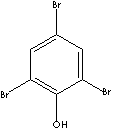PRODUCT IDENTIFICATION

H.S. CODE
TOXICITY
Oral rat LD50: 200 mg/kg
CLASSIFICATION
Flame Retardant, Fungicide, Organobromide
EXTRA NOTES
PHYSICAL AND CHEMICAL PROPERTIES
MELTING POINT
SOLUBILITY IN WATER
AUTOIGNITION
NFPA RATINGS
REFRACTIVE INDEX
178 C
EXTERNAL LINKS & GENERAL DESCRIPTION
http://www.inchem.org/
The
production volume of 2,4,6-tribromophenol was estimated at approximately
2,500 t/year in Japan and 9,500 t/year world-wide in 2001. This
substance is produced in a closed system. This substance is used
almost entirely as a chemical intermediate to make a flame retardant
or directly as a flame retardant. The way to use this substance
as a flame retardant is called "capping" i.e. the terminal
-OH group of a polymer is capped with 2,4,6-tribromophenol which
is then covalently bound to the polymer. The reaction occurs during
polymerization of oxirane to form 2,4,6-tribromophenoxy-ether. Consequently,
the resulting polymer becomes flame retardant/resistant. The presence
of the free substance itself in the polymer would give the resin
a stinking odor because of the sublimating property of the substance
and the resin would not be of commercial value. The potential for
release of this substance from resins “capped" with it are
not higher than the potential for release of 2,4,6-tribromophenol
from polymers added with flame retardants derived from this substance.
Other than that, antiseptic and germicide use (e.g., in pharmaceutical
prepns) is reported [Danish EPA, 2000]. However, the amount is too
small to be detected by the producer of the chemical.
Local: Flame retardant in epoxy, polyurethane, plastics, paper and textiles. Fire extinguishing media. 2,4,6-Tribromophenol is used also as an flame retardant in epoxy, polyurethane, plastics, paper, textiles and others. It can be combined with a synergist such as antimony trioxide for maximum flame retardant performance. Tribromophenol may also be used as an intermediate for the production of other commercial flame retardants and fire extinguishing media. It can be used as an antiseptic agent.
APPEARANCE
BROMINE CONTENT
71.5% min
MELTING POINT
90 C min
LOSS ON DRYING
0.5% max
6.1 (Packing group : III)
Flame Retardant are substances that can be chemically inserted into the polymer molecule or be phisically blended in polymers after polymerization to suppress, reduce, delay or modify the propagation of a flame through a plastic materials. There are several classes of flame retardants; Halogenated Hydrocarbons (Chlorine and Bromine containing compounds and reactive flame retardants), Inorganic flame retardants ( Boron compounds, Antimony oxides, Aluminium Hydroxide, molybdenum compounds, zinc and magnesium oxides ), Phosphorous containing compounds (Organic phosphate esters, phosphates, halogenated phosphorus compounds and inorganic phosphorus containing salts).